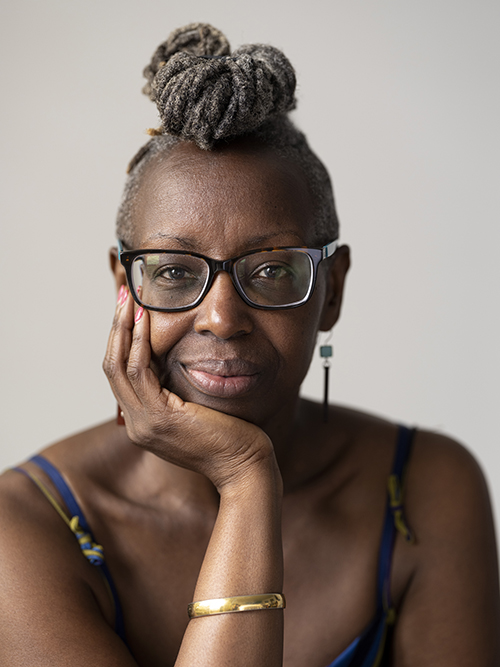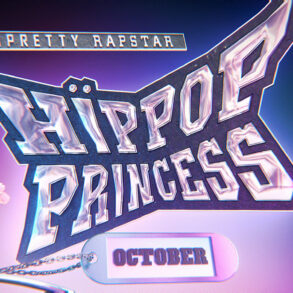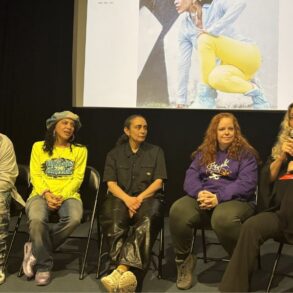“My name is Jasmine (YEAH!)
I got the muscle (YEAH!)
To do the hustle (YEAH!) …
On the video screen (YEAH!)
Well, my hands up high,
my feet down low and thi’s
the way we jig-a-low!”
To the chant, girls create a complex pattern of claps — reversing hands, slapping thighs. Dating back at least to the late 1800s, it’s the most common hand-clapping game in the English-speaking world, according to ethnomusicologist Kyra D. Gaunt, MM ’88.
It’s not the only one. In backyards, on stoops and in playgrounds, Black girls clap opposing palms together to rhyming chants and danced grooves. They embody the percussive beats of Double-Dutch ropes, both their phrases and their footfalls. Emerging male artists often sample these
songs to kickstart their careers, and popular music inspires girls to innovate familiar melodies.
“In some cases, it’s not clear whether the game song came first or if the girls are mirroring popular music,” says Gaunt, who explored the phenomenon in her 2007 Alan Merriam Prize-winning book, The Games Black Girls Play: Learning the Ropes from Double-Dutch to Hip-Hop. “It’s always a tandem relationship between girls and emerging (male) artists in the record industry.”
Gaunt is an assistant professor at the University at Albany with the departments of music and theatre; women’s, gender and sexuality studies, and sociology. She was also a 2020–23 Senior TED Fellow, and her 2018 TED Talk on how the jump rope got its rhythm garnered more than 7 million views on Facebook. Ultimately, that led the directors of Rada Studio to Gaunt when they were invited to pitch a treatment about Black girls to ESPN. The 2023 ESPN-produced documentary short, Black Girls Play, was a category winner at the 2023 Tribeca Film Festival.
Gaunt earned her associate degree at Montgomery Community College, followed by a bachelor’s in voice at the American University in Washington, D.C. In 1985, she headed to SUNY Binghamton — as it was known at that time — for a master’s in vocal performance. She then went on to the University of Michigan Ann Arbor, where she earned her doctorate in ethnomusicology.
At Michigan, she was struck by an epiphany in a music history class: Black music shouldn’t be taught unless you include dance.
“There is no music without movement and no movement without music across the African diaspora,” she explains. “In many African contexts, there is no separate word for music or dance.”
Song and silence
Gaunt hails from Rockville, Md., and can trace her ancestry back nine generations to her maternal great-great-grandparent’s 1855 escape from enslavement in Portsmouth, Va.; the Underground Railroad led them to Springfield, Mass. It’s an opera-worthy story, involving a
yellow fever epidemic, a woman’s daring escape by dressing as a man, a love left behind and a stolen inheritance. In fact, it might become an opera one day: Gaunt relayed it to a young African-American woman composer whose works were premiered at the Albany Symphony last year.
A love of song runs in the family; Gaunt’s maternal grandmother was an opera singer who went to the New England Conservatory of Music with Coretta Scott King, but gave up her voice career to raise a family with her husband.
“My mother says I was reading before I could walk, and I was singing for as long as I can remember,” Gaunt says. In one of her earliest memories, Gaunt sat between her mother’s knees, warbling “Goin’ Out of My Head” by Little Anthony and the Imperials. Her mother was trying to work the kinks out of the toddler’s hair and braid it into plaits — a painful experience for tender-headed Black girls, leaving her prone to wince and wiggle.
“And I think I’m goin’ out of my head
Yes, I think I’m goin’ out of my head
Over you, over you”
An only child, Gaunt was shy and introverted — but found her bliss singing on the makeshift stage of her bedroom. Sometimes, she used the hairbrush as a microphone; other times, she wrapped a towel around her hair, imitating the long, straight hair of white girls that blew in the wind, the beauty standard of the day.
Studying voice performance seemed like a natural choice. But during her Binghamton audition, she faced the worst fate to befall a singer: She lost her voice. It added to the stage fright that dogged her for years.
She was accepted anyway on the strength of her audition tape. Associate Professor of Music Mary Burgess sent her to a top voice specialist in New York City, but Gaunt’s vocal cords remained swollen for six months. The only Black person in the program, she attended voice classes but couldn’t sing, except for daily 15-minute lessons with Burgess to reclaim her sound, note by note.
At the end of her program, she fully recovered and auditioned for conservatories and music schools. Binghamton also provided the opportunity to forge lasting friendships and discover unexpected talents: It turns out that Gaunt can play a mean defensive end in both flag and touch football.
The residence director of Whitney Hall at the time, she played on a team with her undergrad residents in the “quiet dorm.”
“I was a great defensive player,” she says with a smile. “Our team was called ‘Sacks as a Weapon,’ and I was the weapon.”
Once at Michigan, her stage fright struck again. Three years into a doctorate in voice, after an end-of-the-year jury performance marked by a shaky, insecure voice, Willis Patterson — a voice professor and associate dean — recommended that Gaunt consider a future in ethnomusicology. She tried out a class and was instantly smitten.
These days, she has no problems with stage fright and can sing anywhere. The key, she found, is abandoning the obsession with perfectionism that singers typically have.
Music, after all, is all around you. She chanced upon her book topic when she was on her way to a Midwest chapter meeting of the Society for Ethnomusicology and stopped to watch a pair of twin 7-year-old girls playing several hand-clapping game-songs.
“I was like, ‘This sounds just like hip-hop!’ It’s the same: the beats you’re mixing, and you’re keeping time just like a DJ would,” she recalls. “That was the seed of my dissertation and my book.”
The real-life risks of online dancing
In her research, Gaunt points out that Black girls are the tastemakers, but their contributions often go unnoticed.
Take the 2015 song “Watch Me” by Silentó, then 17 years old. What made him a viral sensation: a massively popular YouTube dance video featuring 4-year-old Heaven King, performing the dance moves named in the song. Then there is Jalaiah Harmon, who in 2020 turned a song by Atlanta rapper K-Camp into a TikTok dance trend called “The Renegade.”
“Black girls’ hips take the songs of emerging artists and turn them into hits, and yet they get no credit for it,” Gaunt says. “Everybody profits but the Black girl, who gets to be the butt of Internet jokes about twerking or about concatenated or Africanized names.”
Her current research explores the intersection of music as play, monetized streaming and the hypersexualization or violence targeting Black girls’ dance videos on YouTube. It centers on a data set of 650 bedroom twerking videos and 200 identifiable songs, of which there are 90 unique titles. Only 11 feature female artists.
“That means the girls are dancing mostly to male voices, telling them what to do with their bodies and how to do it,” she says.
Comments from adult men on online dance videos sexualize Black girls and use language associated with grooming for sexual abuse. The tween girls typically don’t interact with these comments, but they may still read them. What does that do to Black and Brown girls? How does that influence expectations of how they’ll be treated both online and away from their devices?
Becoming habituated to psychological and emotional threats through repeated Internet exposure can be dangerous, making young girls less likely to react to real perils such as sexual assault — of which adolescent Black girls are disproportionately at risk, according to a 2011 Centers for Disease Control and Prevention report.
“Girls are the canary in the coal mine. We all suffer from emotional manipulation in the digital age when we’re home watching things; we’re not always aware of its impact on our psyche, psychology and physiology,” Gaunt reflects.
Given the sensitivity of the adolescent brain’s developmental stage, particularly among vulnerable members of a marginalized group, the risks of social media during these years demand closer inspection, she says. Music, too, goes beyond entertainment. The thesis of her next book, under contract with SUNY Press, is that music plays a role in grooming very young Black girls for violence through aspirational musical play in private places such as bedrooms.
“Girls are tastemakers and victims of exploitation,” she says. “That demands closer attention to its risks among parents, policymakers and privatized platforms like YouTube and TikTok.”
This post was originally published on this site be sure to check out more of their content.







